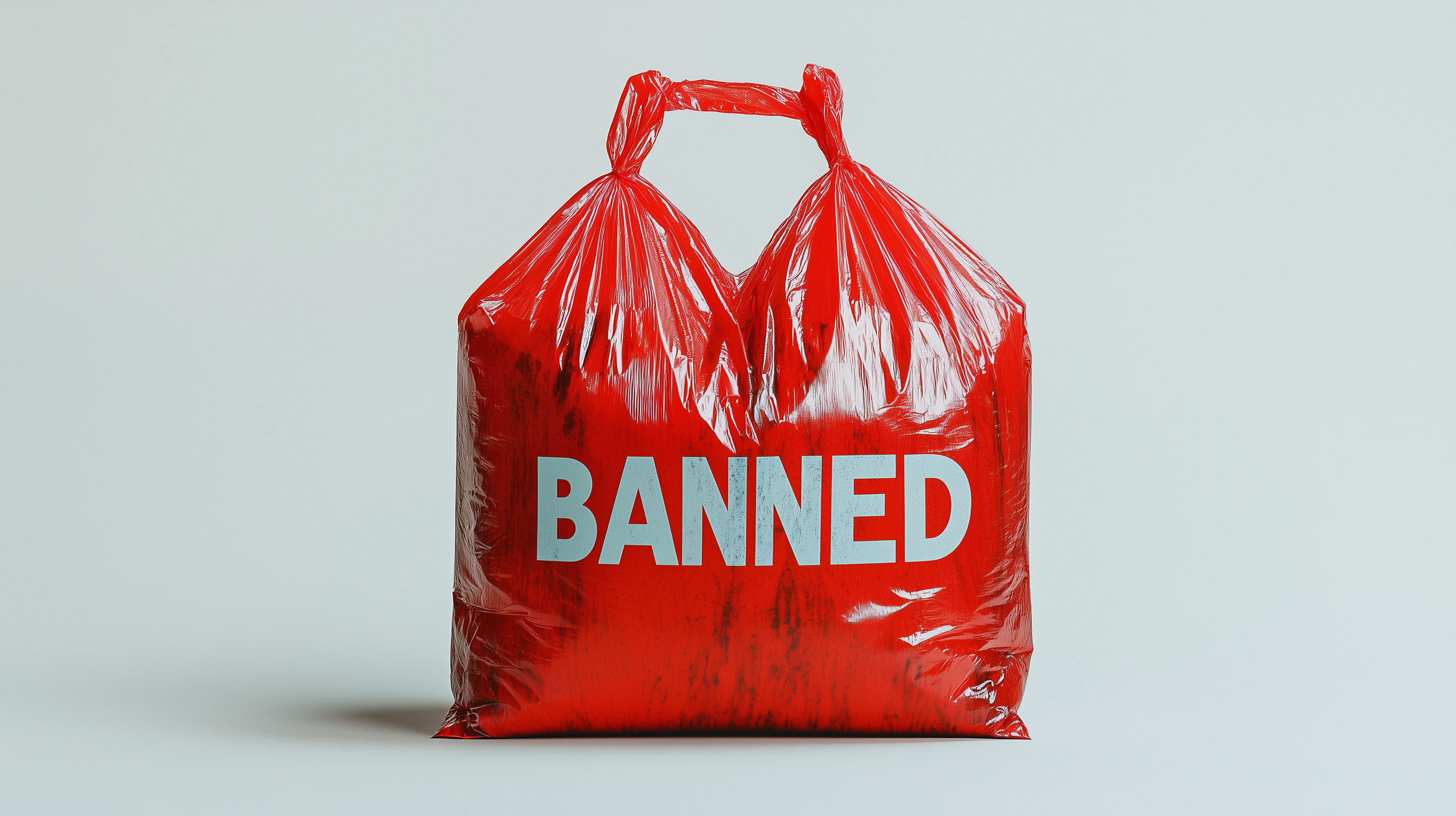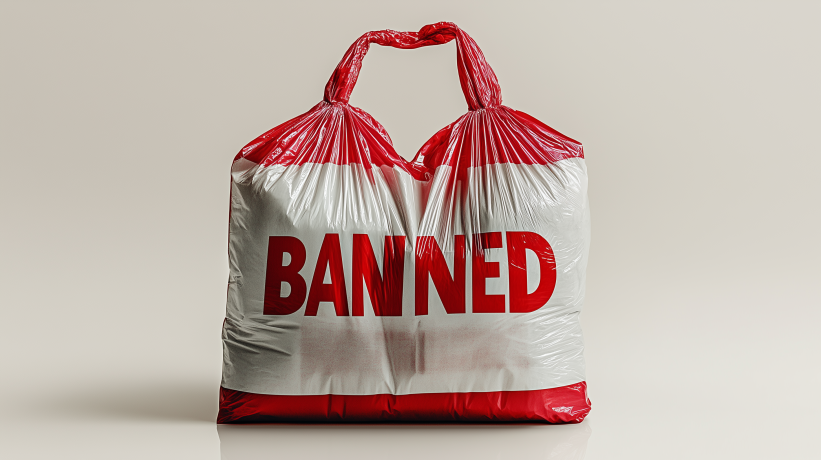
California's SB 1053 tightens plastic bag restrictions, banning most carryout bags at checkout starting 2026. Retailers must charge for recycled paper bags, while consumers need to embrace reusable options to avoid fees and reduce waste.
by LawInc Staff
September 23, 2024
On September 22, 2024, California Governor Gavin Newsom signed Senate Bill 1053 into law, strengthening the state’s existing restrictions on single-use carryout bags. The legislation aims to further curb plastic pollution by prohibiting stores from providing most plastic bags at checkout, leaving consumers to bring their own reusable bags or pay a fee for recycled paper or reusable bags.
This guide provides an overview of SB 1053, explaining the key changes taking effect, the reasoning behind the law, and how it will impact retailers and shoppers across the Golden State. Learn about the specific rules and exceptions, enforcement mechanisms, potential benefits and drawbacks, and more.
Whether you’re a store owner needing to adapt to the new requirements, an environmentally conscious consumer wanting to understand the law’s impact, or a citizen wondering about the societal implications, get all your questions answered here.
1. Understand the Key Provisions of SB 1053
-
- Bans Most Carryout Bags: Prohibits stores from providing, distributing, or selling a “carryout bag” at point of sale, with limited exceptions.
- Eliminates Thicker Plastic Bags: Repeals the exemption for reusable plastic film bags, so they can no longer be sold or distributed at checkout.
- Allows Some Paper Bags for a Fee: Permits stores to sell or distribute recycled paper bags at point of sale for a minimum of 10 cents each.
- Defines Key Terms: Provides specific definitions for “carryout bag,” “recycled paper bag,” “point of sale,” and other relevant terms.
- Sets an Effective Date: The law’s provisions and prohibitions go into effect on January 1, 2026.
Examples:
-
- Beginning in 2026, shoppers at most California grocery, retail, and convenience stores will no longer receive plastic carryout bags at checkout.
- The thicker plastic bags previously considered reusable will be phased out, lessening overall plastic consumption.
- Consumers who don’t bring their own bags can purchase recycled paper bags for at least 10 cents each to carry out purchases.
- “Point of sale” broadly covers in-store, self-checkout, curbside pickup, and delivery transactions to close potential loopholes.
- Retailers have until the start of 2026 to deplete current bag inventories and implement new checkout procedures before enforcement begins.
How It Applies:
-
- Grocery stores, retail outlets, convenience shops, and most other retailers will need to stop offering single-use plastic and thicker reusable plastic bags.
- Stores can still provide recycled paper bags, reusable bags made of approved materials like cloth, or approved compostable bags – just not conventional plastic.
- Expect major retailers to encourage reusable bag use while offering paper bags at checkout for at least the mandatory minimum 10 cent fee.
- Online orders delivered to your home or picked up curbside will be subject to the same rules, so specify in advance if you need to purchase carryout bags.
- To avoid additional costs and waste, customers should get in the habit of always bringing reusable shopping bags, baskets, or totes on grocery runs.
FAQs:
-
- Which stores are covered by SB 1053’s plastic bag ban? Most retail establishments, including grocery stores, convenience shops, pharmacies, and general merchandise sellers.
- Can stores give me free recycled paper or reusable bags instead? No, stores must charge at least 10 cents for each compliant bag provided at checkout.
- What if I forget my reusable bags at home? You’ll need to pay for store-provided paper or reusable bags or carry your purchases out by hand.
- Will the bag ban increase costs for consumers? Only if you regularly purchase carryout bags. Bringing your own avoids new charges.
- Are there any exceptions to the plastic bag prohibition? Yes – bags used in stores before checkout, like produce or bulk food bags, are exempt.
2. Understand the Reasoning Behind the Law
-
- Builds on California’s 2016 Bag Ban: Voters ratified Prop 67 in 2016 to ban most single-use plastic bags, but it still allowed thicker reusable plastic bags.
- Addresses Unintended Consequences: The loophole for thicker HDPE plastic bags led to increased plastic use overall compared to pre-ban levels.
- Reduces Plastic Pollution & Waste: Californians use roughly 500 million plastic bags per month, many of which end up as litter or in landfills.
- Protects the Environment: Plastic bags harm wildlife, contaminate waterways, and break down into microplastics that pollute natural ecosystems.
- Encourages Reusable Bag Use: The law aims to shift consumer habits toward bringing durable, reusable bags to avoid disposable bag waste.
Examples:
-
- The 2016 ban cut thin plastic bag use but spawned a new market for thicker HDPE bags, which customers rarely reused the 125 times required for a net environmental benefit.
- Californians still use over 500 million plastic bags a month, with the average bag getting just 15 minutes of use before being discarded.
- Plastic bags are consistently among the most common litter items found at beach cleanups and often end up in rivers and oceans.
- Scientists estimate that Californians ingest a credit card’s worth of microplastics each week just from bags and packaging breaking down in the environment.
- Reusable bag use increased after the 2016 ban but began declining as stores promoted thicker plastic bags – SB 1053 aims to reverse that trend.
Broader Context:
-
- Plastics have become ubiquitous in daily life, but their convenience comes with major environmental costs, from carbon emissions to pervasive pollution.
- Global plastic production and waste keep growing as recycling fails to keep pace. Only 9% of all plastics ever made have been recycled.
- Lightweight plastic bags are difficult to recycle and aren’t accepted in most curbside programs, so reuse or avoidance is key to curbing their impact.
- Experts warn that plastic leaches toxic chemicals and breaks down into microplastics that contaminate water, food, and even human blood.
- Governments worldwide are pursuing plastic bag restrictions and bans to stem the rising tide of waste and catalyze a shift to sustainable alternatives.
FAQs:
-
- Is there proof that bag bans reduce plastic pollution? Yes, studies show significant drops in bag usage and plastic bag litter in areas with restrictions.
- Do bag laws actually change consumer behavior? Research indicates bans and fees boost reusable bag use and cut overall disposable bag consumption.
- Why not just recycle plastic bags instead of banning them? Plastic bags have low recycling rates, contaminate recycling streams, and still pollute when discarded.
- Don’t paper and reusable bags have environmental impacts too? Yes, but they’re generally less severe than plastics and don’t persist as long in the environment.
- Will this law really make a difference environmentally? Every avoided plastic bag helps, but broader policies are also needed to curb pollution and waste.
3. Identify the Specific Rules and Exceptions
-
- Covered Bags: SB 1053 prohibits “carryout bags” of plastic, paper, or other materials provided at point of sale, unless they meet recycled content standards.
- Exempted Bags: Bags used in-store before the point of sale, like produce, bulk food, meat, unwrapped food item, and pharmacy bags are excluded.
- Recycled Paper Bags Allowed: Stores can provide recycled paper bags with 40%+ post-consumer content for at least 10 cents each until 2028, then 50%+ after.
- Reusable Bags Permitted: Durable, reusable bags like those made from cloth or canvas can be offered in lieu of disposable bags.
- Required Bag Labeling: Reusable and recycled content bags must be labeled with the manufacturer, country of origin, and recycled content percentage.
Examples:
-
- Shoppers can still use the thin plastic bags in the produce aisle to hold apples or from the bulk bin section for nuts – just not at checkout.
- Customers can purchase paper bags made with at least 40% recycled content for a dime or more at the cash register until 2028.
- Pharmacy bags used for medication, paper bags for unwrapped baked goods, and protective plastic bags around meat aren’t restricted.
- Grocery delivery services will use either recycled paper bags or place items loose in bins/totes to comply with the law when packing orders.
- Reusable bags made of synthetic fabrics are allowed if they meet durability standards and are accurately labeled for consumer awareness.
How to Comply:
-
- Retailers should take inventory of current bag supplies and plan to use up non-compliant bags before the 2026 deadline.
- Stores will need to source appropriate recycled, reusable, and compostable bags and develop procedures for providing them to customers.
- Create clear signage, labels, and staff training to help shoppers understand what bags are available and allowed under the new law.
- Implement checkout programming to automatically add bag fees as separate line items and ensure cashiers are applying the rules consistently.
- Consider incentive programs to encourage reusable bag use, like discounts or loyalty perks for customers who bring their own.
FAQs:
-
- Can stores provide free reusable or recycled bags instead of charging? No, the law requires bag fees to avoid subsidizing their cost and disincentivize waste.
- What if customers demand disposable plastic bags? Stores will be liable for fines and penalties if they violate the ban, so employee training is key.
- Will all stores charge the same 10 cent fee for paper and reusable bags? The 10 cent fee is a mandatory minimum, but retailers can charge more.
- How will bag fees be used? Stores keep bag fee revenue but are encouraged to use it for SB 1053 compliance costs and sustainability initiatives.
- Are there any exemptions for low-income shoppers? Yes, EBT/WIC/SNAP customers are entitled to free reusable or recycled bags at checkout.
4. Understand the Potential Benefits and Drawbacks
-
- Environmental Gains: Banning disposable plastic bags will cut litter, conserve resources, protect wildlife and ecosystems, and reduce waste.
- Changing Consumer Habits: The law will spur more Californians to get in the habit of bringing reusable bags when shopping.
- Cost Savings Opportunities: Stores stand to save on bag costs while cities can cut litter cleanup and waste management spending.
- Possible Economic Impacts: Some argue bag bans can negatively impact certain industries and low-income consumers.
- Enforcement Challenges: Ensuring consistent compliance across all covered stores may strain public agencies tasked with enforcement.
Examples:
-
- Studies show California communities with bag restrictions have 50-90% less plastic bag litter in storm drains, rivers and beaches.
- After LA County’s bag ban, reusable bag usage jumped from 18% to 45% of consumers, with most keeping reusable bags in their cars to shop.
- Retailers spend up to 10 cents per disposable bag provided. Eliminating that cost can add up to significant savings to reinvest or pass on to shoppers.
- Some critics claim fees are regressive for low-income shoppers and bans hurt small retailers and plastic industry workers.
- Local enforcement teams may face added work to inspect stores, respond to complaints, and issue violation notices to boost compliance.
Analysis:
-
- While there are valid concerns on both sides, evidence suggests the overall societal benefits of bag restrictions outweigh the drawbacks.
- Significant litter and waste reductions seen in ban areas indicate the policies do change behavior and stem plastic bag pollution.
- Industry doomsday predictions haven’t materialized in areas with bans, as businesses and consumers adapt to available alternatives.
- Bag fees can be offset for low-income shoppers through public assistance exemptions, incentive programs and access to free reusable bags.
- Some increased enforcement and education is expected upfront, but compliance tends to rise over time as policies become the norm.
FAQs:
-
- Do bag bans really save retailers money? Many stores report net savings even with increased use of paper and reusable bags.
- Will jobs be lost due to drops in plastic bag manufacturing? Experience shows most plastic bag makers downsize and shift to reusable bag and film products.
- How much does public education and enforcement cost? Local agencies may see $1-3 million in annual costs depending on the size of their jurisdiction.
- Don’t people just buy plastic bags for trash at home instead? Surveys show only 1/3 of consumers purchase carryout bag alternatives like trash bags.
- Are reusable bags better if they’re resource-intensive? Yes, a cotton bag’s higher “cost” is still a net gain after just 10-20 uses vs. disposables.
5. Consider the Broader Implications and Precedent
-
- A Model for Other Plastic Policies: The passage of SB 1053 could pave the way for additional single-use plastic restrictions in the future.
- Tackling a Major Pollution Source: Plastic bags are one of the most ubiquitous and harmful forms of litter, inspiring action.
- Promoting Sustainable Consumerism: The law challenges the convenience-first mindset and encourages people to make less wasteful choices.
- Holding Industry Accountable: Bag bans put the onus on plastic manufacturers to develop and promote less harmful alternatives to their products.
- Global Momentum for Bag Laws: California’s strengthened ban aligns with a worldwide movement to curb disposable bag pollution for good.
Examples:
-
- Environmental groups and legislators already see SB 1053 as a stepping stone to restrictions on other single-use plastics like cutlery and packaging.
- Research shows plastic bags make up over 40% of trash collected in California waterway cleanups, more than any other item.
- Behavioral studies find policies that disincentivize disposables and provide sustainable alternatives significantly influence consumer habits.
- Some bag makers have started shifting to heavier recycled plastic films and organic materials due to regulatory and public pressure.
- From the EU to India to dozens of countries in Africa, the number of nations with bag laws on the books has exploded in recent years.
The Big Picture:
-
- By targeting plastic bags, SB 1053 confronts one of the most visible and preventable environmental threats posed by our throwaway culture.
- The law reflects a growing understanding that collective action is needed to solve a pollution problem that impacts everyone.
- As awareness grows, people are demanding accountability from the industries most responsible for plastic waste and looking for ways to change behaviors.
- Government policies like bag bans can accelerate the shift to a circular economy where as little as possible is landfilled or littered.
- With the world drowning in plastic, California’s strengthened bag law sets a meaningful example for other decision-makers to follow.
FAQs:
-
- Will this law really make a dent in the plastics crisis? It’s an important step as part of a broader strategy to curb plastic pollution at the source.
- Do bag bans lead to restrictions on other plastics? They can build momentum for further action, but each policy is evaluated separately.
- What other single-use plastics could be targeted next? Likely candidates include disposable foodware, polystyrene foam, and some packaging.
- How effective are bag laws in changing consumer behavior long-term? Research shows significantly reduced disposable bag use and increased reusable bag adoption in ban areas.
- Is there public support for policies like SB 1053? Yes, polling consistently shows a majority of Californians favor restrictions on plastic pollution.
6. Assess the Expected Outcomes and Impact
-
- Reduction in Plastic Bag Pollution: SB 1053 will slash the number of plastic bags that end up in the environment as litter or waste.
- Increased Reusable Bag Use: More Californians will get in the habit of bringing their own bags to avoid fees on store-provided options.
- Economic Impacts Across Sectors: Retailers may see cost savings, while some plastic industry jobs could be lost or transitioned to alternatives.
- Necessary Enforcement Efforts: Stores will need to be monitored for compliance and consumers educated about the new rules.
- Opportunity for Innovation: The law could spur development of new reusable bag designs and sustainable materials to replace single-use plastics.
Predictions:
-
- Based on other bag laws, SB 1053 could cut California’s plastic bag consumption by billions of bags annually, greatly reducing litter.
- A majority of consumers will likely adapt and start bringing reusable bags within 3-6 months of the law taking effect.
- Some job losses may occur in plastic bag manufacturing, but most companies will likely adapt their products and staffing.
- Widespread retail compliance is expected due to clear regulations and penalties, but some spot violations may persist without strong enforcement.
- Entrepreneurs and existing reusable bag makers will likely capitalize on new demand for sustainable carryout bag alternatives.
Tracking Progress:
-
- Plastic bag litter data collected through volunteer beach cleanups and city street sweeping audits can show reductions over time.
- Consumer surveys and observational studies at retailers can reveal changes in reusable bag usage rates post-implementation.
- Economic analyses can identify SB 1053’s impacts on affected industries, from potential job losses to business savings on bag costs.
- Local enforcement records on violations, fines, and compliance assistance activities will help assess implementation effectiveness.
- Tracking trends in reusable bag designs, materials, and market share can show how the industry evolves in response to the law.
FAQs:
-
- How long will it take to see environmental results? Significant litter reductions are often measured within the first year of bag law implementation.
- Will reusable bags just end up in landfills too? No, most reusable bag materials like cotton can be repurposed or recycled rather than trashed.
- What happens if stores don’t comply with the law? They’ll face fines for each violation and could have their retail license suspended until corrected.
- Will the 10 cent paper bag fee drop over time? Likely not, as the fee is meant to be a permanent disincentive for choosing single-use bags.
- How can I report a store still using plastic bags? Most cities and counties will have a phone or online system for reporting potential violations.
Summary

Did You Know? Over 400 California cities and counties had local bag laws on the books before the statewide ban, covering more than 40% of the state’s population.
California’s passage of SB 1053 marks a major milestone in the global fight against plastic pollution. By banning most disposable plastic bags and closing prior loopholes, the law establishes the nation’s strongest restrictions yet on one of the most ubiquitous and harmful sources of litter.
While not everyone agrees with this approach, mounting evidence suggests policies like bag bans are an effective tool for changing wasteful behaviors and stemming the tide of plastic trash. The law may present some implementation challenges but is expected to deliver significant environmental gains that benefit all Californians.
Test Your SB 1053 Knowledge
Questions: Key SB 1053 Provisions & Changes
-
- 1. When does California’s strengthened plastic bag ban under SB 1053 take effect?
- A) January 1, 2025
- B) July 1, 2025
- C) January 1, 2026
- D) July 1, 2026
- 2. Which types of stores are covered by the plastic bag ban?
- A) Only large grocery stores and supermarkets
- B) Grocery stores, retail stores, convenience stores, and more
- C) Just convenience stores and pharmacies
- D) Only stores over a certain square footage
- 3. Which bags are banned from being provided at point of sale?
- A) All paper and plastic carryout bags
- B) Only compostable plastic bags
- C) Plastic, paper, and other material carryout bags, with exceptions
- D) Just plastic bags, paper is still allowed
- 4. What happened to the previous exemption for thicker reusable plastic bags?
- A) It was removed, so those bags are banned too now
- B) The exemption remains but the bags must be even thicker
- C) Thicker bags can still be used but there’s a 10 cent fee
- D) The thicker bag exemption is unchanged
- 5. What’s the minimum fee stores must charge for allowed recycled paper bags?
- A) 5 cents per bag
- B) 10 cents per bag
- C) 25 cents per bag
- D) No mandatory minimum fee
- 1. When does California’s strengthened plastic bag ban under SB 1053 take effect?
Answers: Key SB 1053 Provisions & Changes
-
- 1. C) The plastic bag ban provisions in SB 1053 become effective starting on January 1, 2026, giving stores time to use up existing bag stock.
- 2. B) SB 1053 applies to most types of retail stores, including grocery, convenience, and general merchandise with a few limited exceptions.
- 3. C) The law prohibits stores from providing most carryout bags at checkout unless they meet recycled content rules or are exempt.
- 4. A) SB 1053 repeals prior allowances for stores to provide thicker reusable plastic film bags, restricting them along with thinner HDPE bags.
- 5. B) If providing paper bags at point of sale, retailers must charge at least 10 cents per bag to encourage reusable bag use instead.
Questions: SB 1053 Exemptions & Requirements
-
- 1. Which bags are exempt from SB 1053’s carryout bag restrictions?
- A) Produce and bulk food bags used before checkout
- B) Pharmacy prescription bags
- C) Bags for unwrapped food items like baked goods
- D) All of the above
- 2. What percentage of recycled content must paper bags contain to be provided at checkout?
- A) At least 20% recycled content
- B) Minimum 40% recycled content until 2028
- C) 100% recycled content only
- D) No recycled content required
- 3. Are stores allowed to provide free recycled paper or reusable bags to all customers?
- A) Yes, they can provide free bags to everyone
- B) No, they must charge at least 10 cents per bag
- C) Only if the customer brings a coupon
- D) Bags must cost at least 25 cents each
- 4. Can stores charge more than 10 cents each for recycled paper bags?
- A) No, they can only charge exactly 10 cents
- B) Yes, 10 cents is just the minimum allowed
- C) They can charge more only with a waiver
- D) Only if the bags have 100% recycled content
- 5. What information must be printed on compliant recycled paper bags?
- A) Just the percentage of recycled content
- B) Only the manufacturer’s name and location
- C) Recycled content, manufacturer name, and country of origin
- D) No labeling required on paper bags
- 1. Which bags are exempt from SB 1053’s carryout bag restrictions?
Answers: SB 1053 Exemptions & Requirements
-
- 1. D) SB 1053 allows exemptions for several types of non-carryout bags used in stores before the point of sale like produce, pharmacy, and bakery bags.
- 2. B) Paper bags provided at checkout must have at least 40% postconsumer recycled content until 2028 when it rises to 50% minimum.
- 3. B) With the exception of WIC and SNAP participants, stores cannot provide free bags at checkout – they must charge 10 cents or more each.
- 4. B) The 10 cent paper bag fee is a mandatory minimum but retailers can choose to charge more per bag if they wish.
- 5. C) Recycled paper bags must be labeled with the minimum recycled content percentage, manufacturer’s name, and the country where they were made.
Need Legal Help?
If you need legal assistance, in any field of law, our free concierge service can connect you with experienced attorneys in any practice area and state. Contact us to learn more.
Also See
The Great Plastic Con: California Sues ExxonMobil for Decades of Recycling Lies










